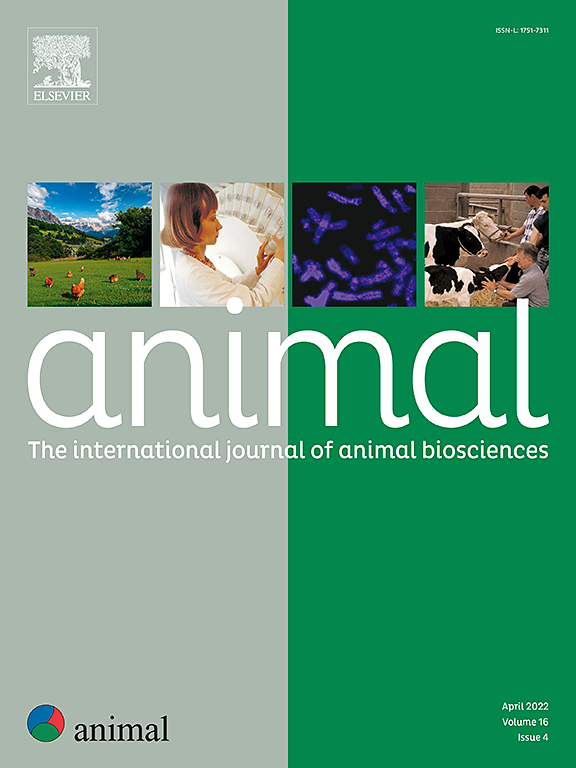Comparison of predictive ability of single-trait and multitrait genomic selection models for body growth traits in Maiwa yaks
IF 4
2区 农林科学
Q1 AGRICULTURE, DAIRY & ANIMAL SCIENCE
引用次数: 0
Abstract
Yaks are grazed extensively on the Qinghai–Tibet Plateau, which has a long history of semi-domestication. The predicted weight of yaks over consecutive years helps make strategic decisions when selecting yak calves for breeding. To achieve more accurate predictions of genomic estimated breeding values, we used a dataset comprising the genotype and weight records of 396 Maiwa yaks collected from 2015 to 2020. We compared the predictive accuracy of the genome best linear unbiased prediction (GBLUP) model with that of six other models. Based on the GBLUP model, we applied two prediction strategies. In the first strategy, the year was treated as a fixed effect in the GBLUP model, and the kinship from all individuals and the markers were treated as random effects. In the second strategy, all individuals were divided into six age groups, with GBLUP performed for each group, and the phenotypes of the closest age groups were treated as fixed effects. Although the GBLUP model provided better prediction accuracy than other single-trait models, most of the predictive capacity was derived from the best linear unbiased estimation. Additionally, incorporating the phenotype of the closest age group as a factor in multitrait prediction enhanced the accuracy of the model. Our findings provide a robust and credible strategy for predicting continuous economic traits in the presence of strong correlations.
麦洼牦牛身体生长性状的单性状和多性状基因组选择模型的预测能力比较。
牦牛在具有悠久半驯化历史的青藏高原被广泛放牧。预测牦牛连续几年的体重有助于在选择牦牛幼崽进行繁殖时做出战略性决策。为了更准确地预测基因组估计育种值,我们使用了一个数据集,其中包括从 2015 年到 2020 年收集的 396 头麦洼牦牛的基因型和体重记录。我们比较了基因组最佳线性无偏预测(GBLUP)模型与其他六个模型的预测准确性。在 GBLUP 模型的基础上,我们采用了两种预测策略。在第一种策略中,年份在 GBLUP 模型中被视为固定效应,所有个体的亲缘关系和标记被视为随机效应。在第二种策略中,所有个体被分为六个年龄组,每组进行 GBLUP,最接近年龄组的表型被视为固定效应。虽然 GBLUP 模型比其他单性状模型提供了更好的预测准确性,但大部分预测能力来自最佳线性无偏估计。此外,将最接近年龄组的表型作为多性状预测的一个因素也提高了模型的准确性。我们的研究结果为预测存在强相关性的连续经济性状提供了一种稳健可靠的策略。
本文章由计算机程序翻译,如有差异,请以英文原文为准。
求助全文
约1分钟内获得全文
求助全文
来源期刊

Animal
农林科学-奶制品与动物科学
CiteScore
7.50
自引率
2.80%
发文量
246
审稿时长
3 months
期刊介绍:
Editorial board
animal attracts the best research in animal biology and animal systems from across the spectrum of the agricultural, biomedical, and environmental sciences. It is the central element in an exciting collaboration between the British Society of Animal Science (BSAS), Institut National de la Recherche Agronomique (INRA) and the European Federation of Animal Science (EAAP) and represents a merging of three scientific journals: Animal Science; Animal Research; Reproduction, Nutrition, Development. animal publishes original cutting-edge research, ''hot'' topics and horizon-scanning reviews on animal-related aspects of the life sciences at the molecular, cellular, organ, whole animal and production system levels. The main subject areas include: breeding and genetics; nutrition; physiology and functional biology of systems; behaviour, health and welfare; farming systems, environmental impact and climate change; product quality, human health and well-being. Animal models and papers dealing with the integration of research between these topics and their impact on the environment and people are particularly welcome.
 求助内容:
求助内容: 应助结果提醒方式:
应助结果提醒方式:


